Birdfinding.info ⇒ The East African form of Helmeted Guineafowl is common in its small range. It can be found conveniently near the region’s largest city in Nairobi National Park, and in most of the popular protected areas of southern Kenya and northern Tanzania, including Amboseli, Lake Nakuru, Serengeti, Tarangire, and Tsavo National Parks, and Maasai Mara National Reserve.
“Reichenow’s Guineafowl”
Numida meleagris reichenowi
Endemic to southern Kenya and northern and central Tanzania, where it inhabits savannas, brushlands, and other open and semiopen habitats.
Identification
A typical guineafowl: deep-bodied with a long, thin neck and small, mostly unfeathered head. The body and wings are blackish and densely covered with white spots throughout.
“Reichenow’s” can be distinguished from other forms of Helmeted Guineafowl by the color and shape of its bare parts: a tall orange casque; bright aqua-blue skin on the face and down the sides of the neck (sometimes becoming more purplish on the neck); black throat-wattles; and broad, red cheek-wattles.
From a distance, the head of “Reichenow’s” appears tricolored: dull-orange above the eye, red in front of and below the eye, and vivid turquoise from cheek to neck.

“Reichenow’s Guineafowl,” N. m. reichenowi. (Narok, Maasai Mara National Reserve, Kenya; October 21, 2019.) © Susan Mac

“Reichenow’s Guineafowl,” N. m. reichenowi, with a pointed triangular casque. (Nairobi National Park, Kenya; November 27, 2013.) © Richard Dunn
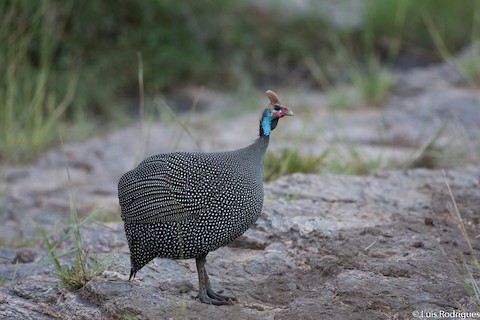
“Reichenow’s Guineafowl,” N. m. reichenowi, showing a remarkably small head-to-body ratio. (Olare Motorogi Conservancy, Kenya; June 20, 2015.) © Luis Rodrigues

“Reichenow’s Guineafowl,” N. m. reichenowi, with a short casque and somewhat unusual coloration including extensive blue skin on the neck. (Mara Triangle, Maasai Mara National Reserve, Kenya; January 24, 2017.) © Roberto Dall Agnol
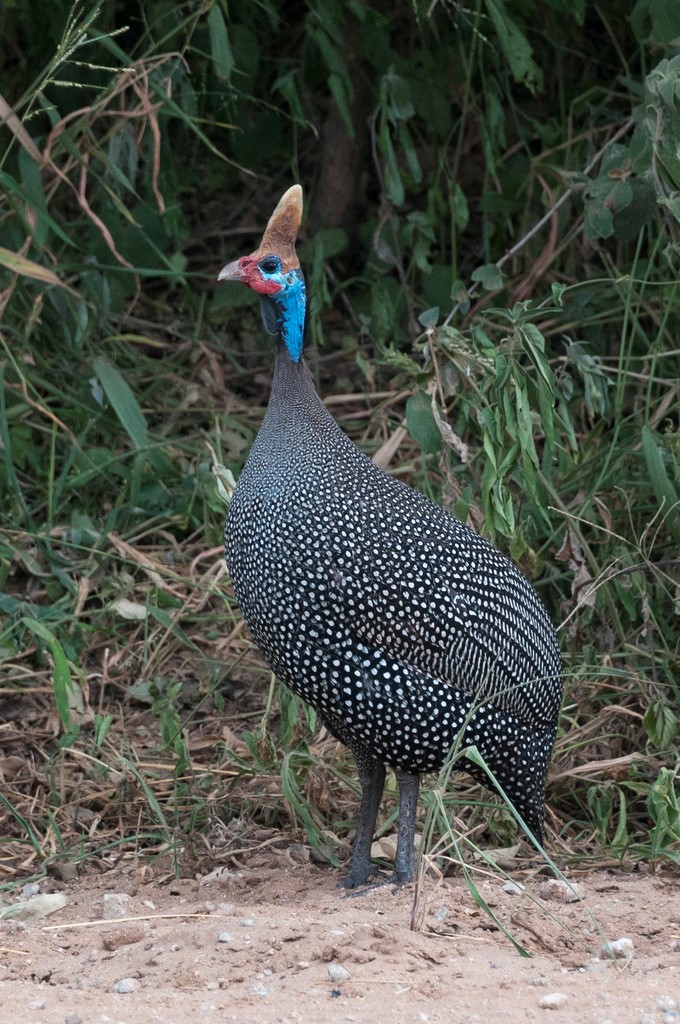
“Reichenow’s Guineafowl,” N. m. reichenowi, showing its distinctively tall, vertical casque. (Tarangire National Park, Tanzania; February 14, 2015.) © Joni Overbosch
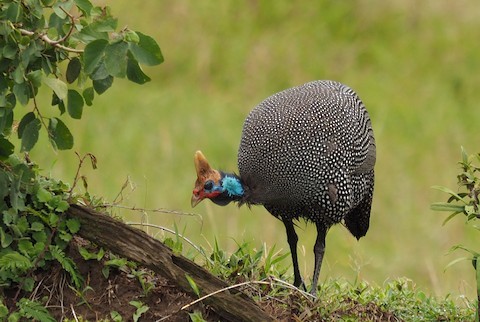
“Reichenow’s Guineafowl,” N. m. reichenowi. (Maasai Mara National Reserve, Kenya; January 24, 2019.) © Kerem Ali Boyla

“Reichenow’s Guineafowl,” N. m. reichenowi. (Lake Nakuru National Park, Kenya; May 21, 2018.) © Lynne Hertzog

“Reichenow’s Guineafowl,” N. m. reichenowi, with a large, triangular casque. (Naboisho Conservancy, Kenya; January 20, 2020.) © James East
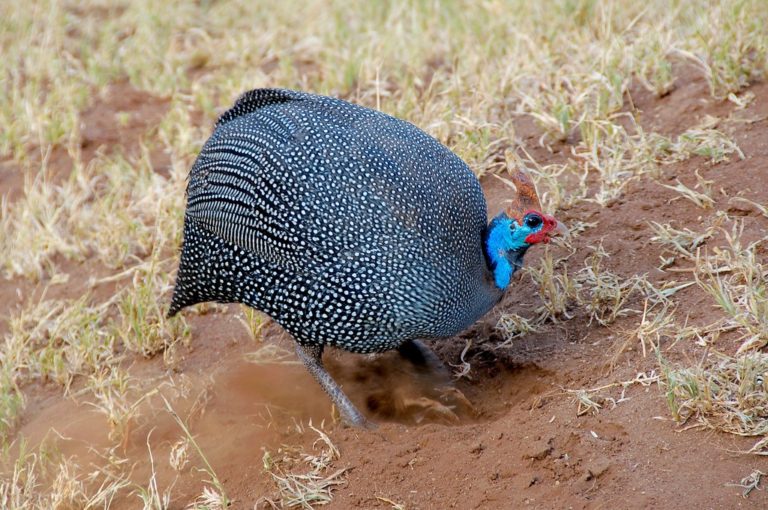
“Reichenow’s Guineafowl,” N. m. reichenowi. (Babati, Tanzania; February 10, 2013.) © Joni Overbosch

“Reichenow’s Guineafowl,” N. m. reichenowi, showing how the intense blue skin color stands out at a distance. (Nairobi National Park, Kenya; November 11, 2019.) © Charley Hesse – TROPICAL BIRDING

“Reichenow’s Guineafowl,” N. m. reichenowi, showing how the intense blue skin color stands out at a distance—note the variation in casque height. (Lake Naivasha, Kenya; December 3, 2019.) Anonymous eBirder
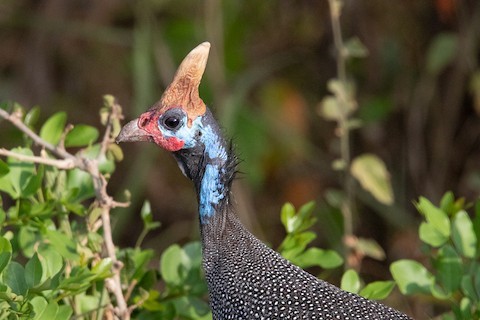
“Reichenow’s Guineafowl,” N. m. reichenowi. (Maasai Mara National Reserve, Kenya; August 23, 2018.) © Alex G.
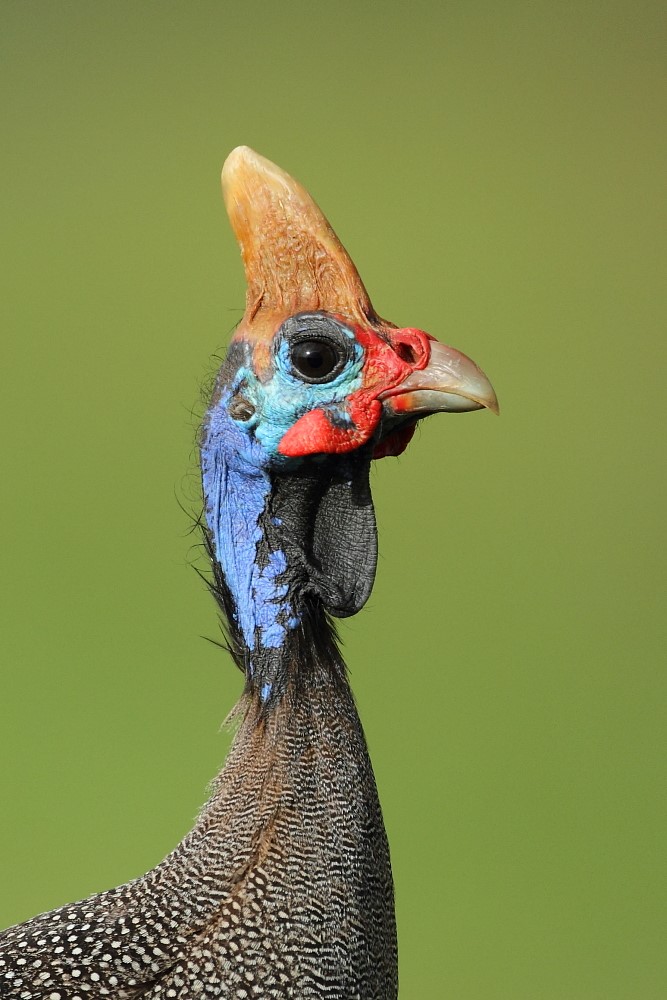
“Reichenow’s Guineafowl,” N. m. reichenowi, showing its distinctively tall orange-brown casque, colorful caruncles, and black dewlap—but note that the side of its neck is purplish instead of turquoise. (Tarangire National Park, Tanzania; February 2, 2013.) © Darran Rickards
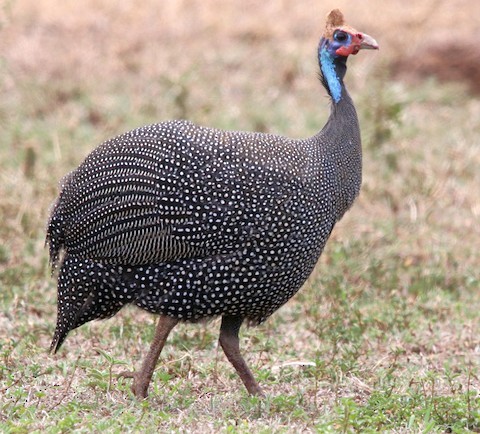
“Reichenow’s Guineafowl,” N. m. reichenowi, with a small casque. (Amboseli National Park, Kenya; October 6, 2019.) © Loren Kliewer
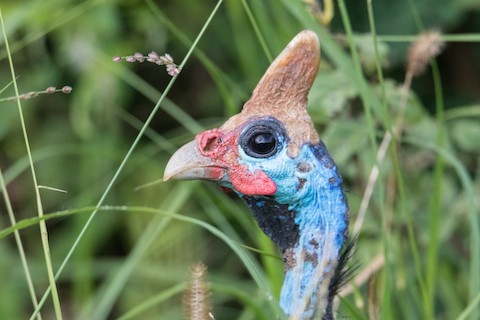
“Reichenow’s Guineafowl,” N. m. reichenowi. (Tsavo West National Park, Kenya; January 3, 2020.) © Peter Steward
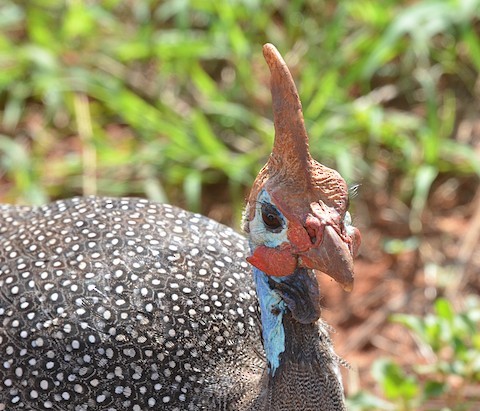
“Reichenow’s Guineafowl,” N. m. reichenowi, close-up showing the structure of its tall vertical casque. (Taita Hills Wildlife Sanctuary, Kenya; March 7, 2017.) © Roland Gerstmeier
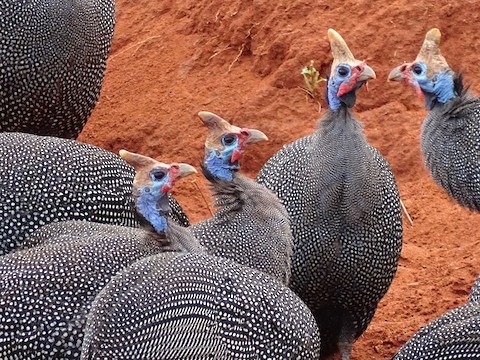
“Reichenow’s Guineafowl,” N. m. reichenowi, a group showing somewhat unusual coloration, including limited red cheek-wattles and purplish skin on their necks. (Tsavo East National Park, Kenya; August 2, 2017.) © Doris Schaule
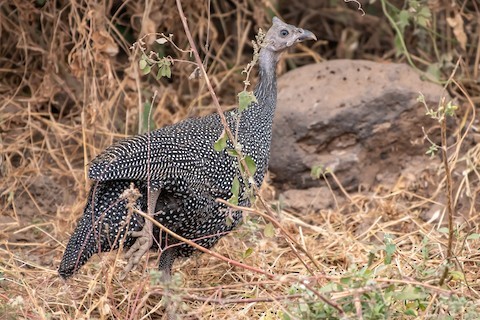
“Reichenow’s Guineafowl,” N. m. reichenowi, immature. (Amboseli National Park, Kenya; August 16, 2018.) © James Hoagland
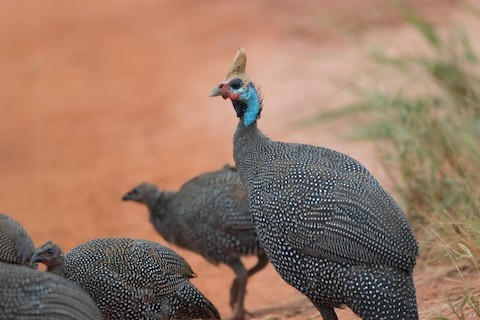
“Reichenow’s Guineafowl,” N. m. reichenowi, adult with immatures. (Tsavo West National Park, Kenya; February 12, 2020.) © Raymond Birkelund
Cf. Other Helmeted Guineafowl. The forms of Helmeted Guineafowl are usually distinguishable based on the color and shape of the bare parts—although there is some internal variation within each form, as well as hybridization and some degree of apparent intergradation.
“Moroccan” has a small brown casque with elongated, upward-pointing feathers on the back of the head, whitish facial skinwhitish facial skin, and a “handlebar moustache” that consists of a long, broad, curled red wattle on each cheek, and a fleshy red connection across the cere.
“West African” has a small brown casque, whitish facial skin, and a “handlebar moustache” that consists of a long, broad, curled red wattle on each cheek, and a fleshy red connection across the cere.
“Ethiopian” has a small-to-medium-sized brown casque, bluish facial skin, and a cluster of bristles on the cere.
“Reichenow’s” has a very tall orange-brown casque, turquoise facial and neck skin, a black dewlap, and a “handlebar moustache” that consists of a long, broad, curled red wattle on each cheek, and a fleshy red connection across the cere.
“Tufted” has a tall orange-brown casque with a red base, red cere, turquoise facial and neck skin, a dark-blue or violet dewlap, and long, thin, pointed cheek-wattles that are bluish with red tips.

“Reichenow’s Guineafowl,” N. m. reichenowi, the champion of helmets, showing its distinctively tall orange-brown casque, red caruncles, turquoise cheeks, purplish neck-skin, and black dewlap. (Tarangire National Park, Tanzania; February 2, 2013.) © Darran Rickards
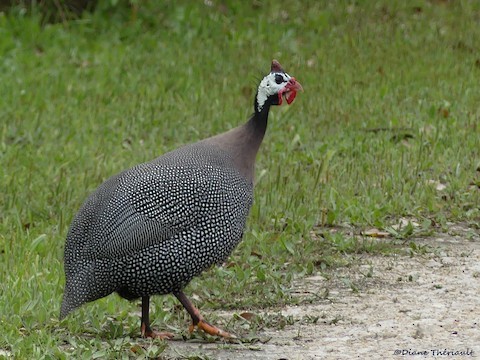
“West African Guineafowl,” N. m. galeatus, showing distinctive white facial skin, small casque, and red “handlebar moustache.” (Goose Island State Park, Texas; April 1, 2019.) © Diane Thériault
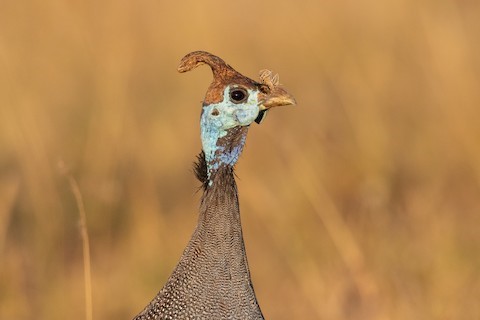
“Ethiopian Guineafowl,” N. m. meleagris, showing its small brown casque, bluish facial skin, and cluster of bristles on the cere. (Yabello, Oromia, Ethiopia; December 30, 2019.) © Stefan Hirsch

“Tufted Guineafowl,” N. m. mitratus, showing its orange-brown casque with a red base, red cere, turquoise facial and neck skin, a dark-blue dewlap, and long, thin cheek-wattles that are bluish with red tips. (Kruger National Park, South Africa; April 18, 2019.) © Guenther Karmann
Notes
Monotypic form. One of five potentially distinct forms of Helmeted Guineafowl (Numida meleagris). See Frontiers of Taxonomy: The Many-Helmeted Guineafowl, an Awkward Foursome.
References
BirdLife International. 2018. Numida meleagris. The IUCN Red List of Threatened Species 2018: e.T22679555A132052202. https://dx.doi.org/10.2305/IUCN.UK.2018-2.RLTS.T22679555A132052202.en. (Accessed April 15, 2020.)
eBird. 2020. eBird: An online database of bird distribution and abundance. Cornell Lab of Ornithology, Ithaca, N.Y. http://www.ebird.org. (Accessed April 15, 2020.)
Madge, S., and P.J.K. McGowan. 2002. Pheasants, Partridges, and Grouse: A Guide to the Pheasants, Partridges, Quails, Grouse, Guineafowl, Buttonquails, and Sandgrouse of the World. Princeton University Press, Princeton, N.J.
Martínez, I., and G.M. Kirwan. 2020. Helmeted Guineafowl (Numida meleagris). In Handbook of the Birds of the World Alive (J. del Hoyo, A. Elliott, J. Sargatal, D.A. Christie, and E. de Juana, eds.). Lynx Edicions, Barcelona. https://www.hbw.com/node/53526. (Accessed April 15, 2020.)
Xeno-Canto. 2020. Helmeted Guineafowl – Numida meleagris. https://www.xeno-canto.org/species/Numida-meleagris. (Accessed April 15, 2020.)
